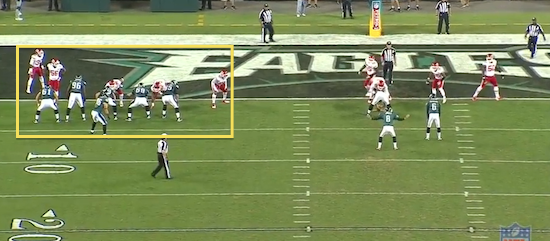All-22: Why the Swinging Gate Two-Point Attempt Failed
Because we have some extra time this week, we’ll split up the All-22 pieces into a bunch of shorter posts.
First, let’s start with the failed two-point conversion in the first quarter.
Chip Kelly’s explanation on Friday: “If you get an opportunity to get an extra point, and in this game, every game’s close. If you get a chance to steal a point here or there, in the long run, it can really benefit you.”
The Eagles set up in the swinging gate formation.
The thinking here is the same as with the Eagles’ packaged plays. They’re looking for numbers in the box. Only in this case, the box happens to be to the left, away from where the ball is being snapped.
As you can see, the Eagles have an advantage: six against five, including the ball-carrier. That means if they can execute hat-on-hat blocks from the 2-yard line, the play should work.
Here is the blocking design. The key is Lane Johnson on the end. He’s supposed to block Tamba Hali, but instead lets him go by untouched. At first, because Johnson made no attempt to block Hali, I thought the scheme might be similar to the zone read where the edge defender is left unblocked on purpose.
But Kelly dispelled that notion.
“Missed assignment,” he said. “We got five guys, they have five guys. Should have blocked the five‑on‑five and we’ve got a shot at it.”
As you can see below, he’s telling the truth. Good blocks by Bennie Logan and Todd Herremans opened up a nice running lane for Zach Ertz.
As Jimmy Kempski pointed out over at Philly.com, the lateral by Jon Dorenbos was behind Ertz. And once he got the ball, Hali was already exploding into the backfield untouched.
Even in this shot, you can see the hole is open between Herremans and Logan.
As T-Mac pointed out yesterday, just because the play failed doesn’t mean Kelly is going to change his tactics. He’s just as likely to go for two against the Broncos next week as he was against the Chiefs. If anything, he might devote more practice time to this option.
What needs to go right for the play to work?
1. The Eagles have to have numbers.
2. The pass has to be on target.
3. The offensive linemen have to properly execute their blocks.
Kelly will have to determine what’s reasonable to expect from his players in a situation like this.
But as always, it comes down to math. Five against five should be a win. And two is better than one.
Follow Sheil Kapadia on Twitter and e-mail him at skapadia@phillymag.com.
Become a fan of Birds 24/7 on Facebook.
